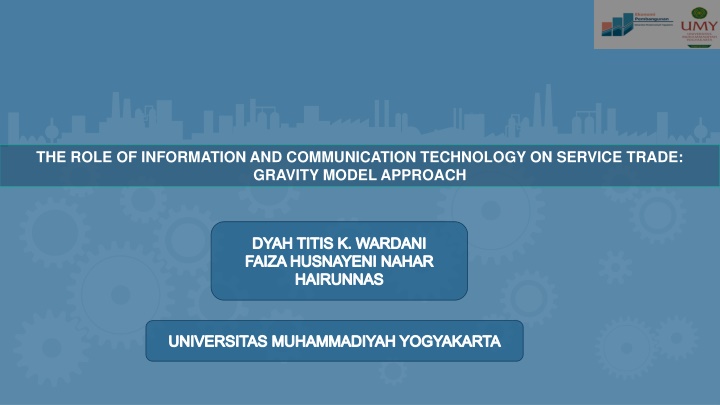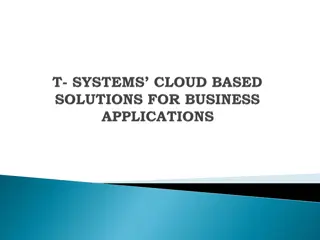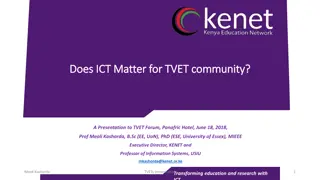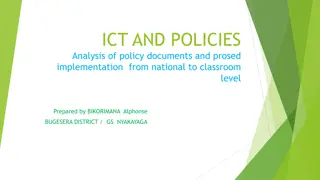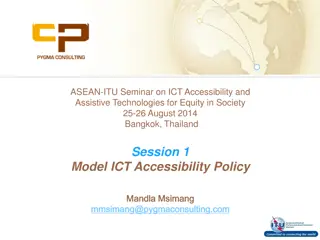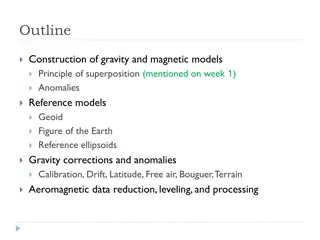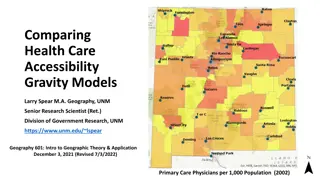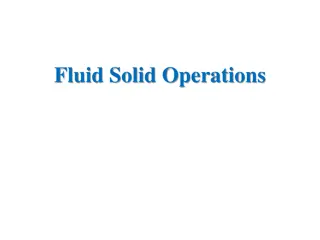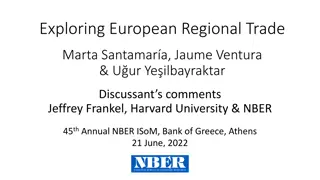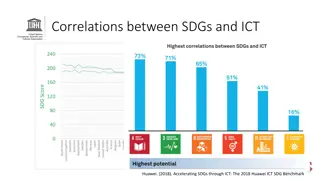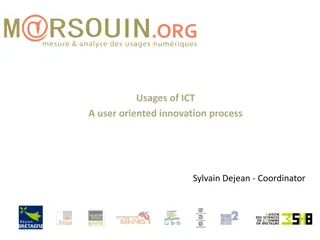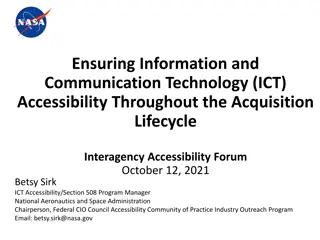The Role of ICT in Service Trade: Gravity Model Approach
Information and Communication Technology (ICT) plays a crucial role in international service trade, with the application of the gravity model theory to analyze the flow of trade. This study explores how technology, particularly ICT, influences service trade within the ASEAN region. It delves into the increasing importance of services in economic output and the role of technology in facilitating cross-border service provision. The gravity model, inspired by Newton's law of gravity, helps explain the attraction between countries in terms of trade relationships.
Download Presentation

Please find below an Image/Link to download the presentation.
The content on the website is provided AS IS for your information and personal use only. It may not be sold, licensed, or shared on other websites without obtaining consent from the author.If you encounter any issues during the download, it is possible that the publisher has removed the file from their server.
You are allowed to download the files provided on this website for personal or commercial use, subject to the condition that they are used lawfully. All files are the property of their respective owners.
The content on the website is provided AS IS for your information and personal use only. It may not be sold, licensed, or shared on other websites without obtaining consent from the author.
E N D
Presentation Transcript
THE ROLE OF INFORMATION AND COMMUNICATION TECHNOLOGY ON SERVICE TRADE: GRAVITY MODEL APPROACH DYAH TITIS K. WARDANI FAIZA HUSNAYENI NAHAR HAIRUNNAS UNIVERSITAS MUHAMMADIYAH YOGYAKARTA
BACKGROUND ASEAN INTEGRATION IN SERVICE Free flow of trade in services is one of the important elements in realizing ASEAN Economic Community, where there will be substantially no restriction to ASEAN services suppliers in providing services and in establishing companies across national borders within the region, subject to domestic regulations. (ASEAN Economic Community Blueprint, November 2007) Services are increasingly important components of economic output in any country. While agriculture and manufacturing remain very important, services continue to gain importance and share in any country s Gross Domestic Product (GDP).
BACKGROUND THE ROLE OF TECHNOLOGY: INFORMATION AND COMMUNICATION TECHNOLOGY (ICT) Technology plays an important role in international trade and commerce since international trade is one of the sources of growth. Salvatore (2004) said that international trade is as one of the engines of growth. With rapid advances in Information and Communication Technology (ICT) since the 1990s, as well as increased efficiency for transport of goods and people across national boundaries, the variety of sectors and volume of services provided across national boundaries are rising fast. More and more people are traveling abroad to consume tourism, education and medical services, as well as to supply services ranging from construction to software development. Likewise, more and more business transactions and delivery of services projects such as engineering design and financial market consultancy are undertaken through electronic channel such as internet and other telecommunication network.
GRAVITY MODEL THEORY The gravity model basically adopts Newton's law of gravity, that is, every particle in the universe will experience an attractive force with one another Tinbergen (1962) used the analogy of the law of gravity equation from Newton to analyze the flow of international trade. According to Tobler (2004), the gravity model can explained in scale ? = ??1?2 ? ???? ??? Iij = ?G Keterangan: F : Attractive force between two objects (M) m1 : Mass of object 1 (kg) m2 : Mass of object 2 (kg) r : Distance between two objects (m) g : Gravity constant I : Gravity between places Pi : Number of population origin country Pj : Number of population partner countries ? : Destination ??? G : Coefficient of proportionality
Research Limitation 1. To analyze the effect of ICT and other determinant factors that affect on service trade ASEAN from 2005 to 2017. 3. Independent Distance, GDP of Indonesia, GDP of partners (9 ASEAN Countries) and telephone cellular access. variables such as 2. Commodities are service products Research Questions (?) Research Objectives 1. What is the effect of standard gravity variables such as distance, GDP of Indonesiai. GDP of partnersj on service trade between Indonesia and ASEAN countries, 2005-2017? 1. To examine the effect of standard gravity variables such as Distance, Indonesiai. GDP of partnersj on service trade between Indonesia and ASEAN countries, 2005-2017? GDP of 2. To what extent is the effect of telephone cellular access on service trade between Indonesia and ASEAN countries, 2005-2017? 2. To examine the effect of Telephone cellular access on service trade between Indonesia andASEAN countries, 2005-2017?
Why the observation starts from 2005? The subsequent decision at the 11th ASEAN Summit in December 2005 to accelerate the liberalisation of trade in services by 2015, re-affirms the seriousness of ASEAN to further integrate its services sector and deepen its economic integration process
RESEARCH FRAMEWORK Distance - GDP Indonesia + Service Trade Indonesia to ASEAN GDP Partners + Telephone cellular access +
RESEARCH METHODOLOGY DATA ANALYSIS METHOD Analysis is using random effect model DATA This research using secondary data 4 2 1 3 OBSERVATION DATA SOURCE This research using panel data are obtained from UN-Comtrade, World Bank, www.distancefromto.net, and www.itu.int Service Export Indonesia to ASEAN-9 from 2005 to 2017
RESULTS AND DISCUSSION Multicollinearity Test Heteroscedasticity with White Test Variabel VIF 1.33 1.69 2.34 2.20 Chi2(1) Pro > Chi2 1.37 0.2551 Ln GDP Indonesia Ln GDP partners Ln Distance Telephone cellular access Mean VIF 1.84 Probability more than 0.05, then regression result is free from heteroscedasticity VIF less than 5 or 10, then regression result is free from multicollinearity (Montgomery, 2001)
ANALISIS PEMILIHAN MODEL Hasil Estimasi Model Chow Test Lagrange Multiplier Test Common Effect Fixed Effect Random Effect Independent Variables chibar (01) Prob > chibar 10.16 0.0007 Effect Test Prob . 4.39 0,0030 14.0301 14.0301 9.8519 Constant F(5,229) Prob > F 9.8596 9.8596 0.9990 Standard Error 0.158 0.158 0.324 P-Value 1.0199 1.0199 0.8882 Ln GDP Indo 0.3612 0.3612 0.3768 Standard Error 0.006 0.006 0.018 P-Value 1.3321 1.3321 1.3604 Ln GDP partners 0.0437 0.0437 0.0919 Standard Error 0.000 0.000 0.000 P-Value Hausman Test -.9353 -.9353 -0.9305 Ln Distance chi (6) Prob > chi 1.23 0.0987 0.0994 0.1970 Standard error 0.8740 0.000 0.000 0.000 P-Value 0.0063 0.0063 0.0048 Telephone Cell .0019 0.001 0.0022 Standard Error 0.013 0.000 0.034 P-Value
CONCLUSION 1. Gross Domestic Product (GDP) both Indonesia (the country of origin) and its ASEAN trading partners have positive and significant effect on Indonesia's service exports to ASEAN. The greater GDP of a country represent economic of scale and for country partners these represent product market. Therefore, to increase export, a country that has higher GDP is directed to trade with a country that have higher GDP. 2. Distance between Indonesia its ASEAN trading partners has a negative and significant effect on Indonesia's service exports to ASEAN. This in line with the Gravity model theory. Since the higher distance, the higher cost of transportation and shipping cost. Even though ICT development in progress nowadays, distance still matter for trade costs. 3. Telephone cellular access has positive and significant effect on Indonesia's service exports to ASEAN. By the development of ICT, such as communication access i.e. telephone cellular access, this may reduce the trade cost. For instance, trader do not need to have face to face interaction, merely they only have correspondence through telephone cellular and this may reduce trade costs, therefore this efficiency may increase trade volume (export).
RECOMMENDATION 1.The Indonesian government is recommend to trade with a country that has higher GDP, since the higher GDP, the higher trade (export). 2. Since the higher distance, the higher cost of transportation and shipping cost. Therefore, the Indonesian government have to make transportation and shipping cost more efficient to reduce trade costs. 3. The Indonesian government should develop ICT in term of trade, such as telephone cellular access. This role can be handled by PT Telkom Indonesia. For instance to strengthen networking and infrastructure of telecommunication. To build more Base Transceiver Station (BTS) located in trade partners countries in ASEAN, for example Telin Singapore established by Telkom Indonesia is officially established in 2007 and is the first Telkom footprint in international business. 4. The Indonesian government need to continue the implementation of Information and Communication Joint Committee Indonesia-Singapore. As 3rd Information and Communication Joint Committee is held in Yogyakarta in 2012.
REFERENCES Alam, S. (2007). Ekonom, Jilid 2. Jakarta:Esis. Adnyana (2016) Review Skema ACFTA terhadap Ekspor Indonesia ke Tiongkok, Hongkong dan ASEAN Universitas Nasional Jakarta. Jakarta. Anderson, J. E. (2016). The Gravity Model of Economic Interaction. Boston College. ASEAN. (t.thn.) Association of Southeast Asian Nations. Dari: https://asean.org/asean/about-asean/. Di akses pada tanggal 2 April 2019. Amador dan Cabral. 2008. The Portuguese Export Performance in Petspetive: A Constant Market Share Analysis. Anderson. J. E. (2016). The Gravity Model of Economic Interaction. Boston College. Association of Southeast Asian Nations. https://asean.org/asean/about-asean/. Retrieved on 2 April 2019. Baltagi, B. H., 2005. Econometric Analysis of Panel Data. 3rd Ed. West Sussex: John Wiley and Sons Ltd. Besedes dan Byle. 2010. An Analysis of Export Duration in Latin America. Distancefromto www.distancefromto.net (2019). Jjarak Indonesia dengan Negara-negara ASEAN . Retrieved from
Elshehawy et al. 2014. The Factors Affecting Egypts Export: Evidence from the Gravity Model Analysis. Ekanda (2014) Ekonomi Internasional. Jakarta: erlangga. Ginting (2013) Pengaruh Nilai tukar terhadap Ekspor Indonesia P3DI. Jakarta. IDI (2019). Pengelompokan IDI (ICT Development Index) diambil dari: www.itu.int Jayadi, A. (2016) berjudul Peta Persaingan Produk Ekspor Indonesia, Malaysia, Singapura Dan Thailand . Lidya (2012) Analisis Faktor-faktor yaang Mempengaruhi Ekspor Indonesia Tahun 1988-2008 . Universitas Gajah Mada. Yogyakarta. Lubis (2010) Analisis Faktor Yang Mempengaruhi Kinerja Ekspor Indonesia . Buletin Ilmiah Litbang Perdagangan, Vol. 4 No. 1. Laksmita (2019) Analisis Total Ekspor Indonesia ke 21 Negara Emerging Markets Tahun 2003 2015 . Universitas gajah mada. Yogyakarta. Mohsen, A. S. (2015). Effect of Exports and Invesment on the Economic Growth in Syria. International Journal of Management, Accounting, and Economics. Vol 2, No. 6. Mankiw, G.N. (2007). Makroekonomi Edisi ke-6. Jakarta: Erlangga: Gelora Aksara Pratama. Mankiw, G.N. (2003). Macroeconomics 5th Edition. New York: Worth Publishers.
Mankiw, G. N. (2012). Principles of Macroeconomics, Sixth Edition. Canada: Cengage Learning. Montgomery, D.C., Peck,E.A., Vining, G.G. 2001. Introduction to Linear regression Analysis, 3rd edition, Wiley, New York. Nopirin. (2014). Ekonomi Internasional. Yogyakarta: BPFE. Spero, J. A. H. (2003). International Trade and Domestic Politics",The Politics of International Economic Relations. Boston: Wadsworth. Sukirno, S. (2012). Makroekonomi Teori Pengantar; Edisi Ketiga. Jakarta: Rajawali Pers. Salvatore, D. (2004). Prinsip-prinsip Ekonomi. Jakarta: Erlangga. Salvatore, D. (1997). Ekonomi Internasional (Kelima). Jakarta: Erlangga. Sunardi (2014). Analisis Daya Saing Dan Faktor Penentu Ekspor Komoditas Unggulan Indonesia ke Organisasi Kerjasama Islam (OKI) Institut Pertanian Bogor. Bogor. Tinbergen, J. (1962). An Analysis of World Trade Flows in Shaping the World Economy, edited by Jan Tinbergen. Twentieth Century Fund. New York, NY.
Trade Map. (2019). Ekpor ASEAN ke dunia 2014-2018. https://www.trademap.org/Index.aspx. Accessed on 17 February 2019. UN Comtrade. (2019). Data Ekspor Servis Indonesia ke ASEAN. Retrieved from UN Comtade: http://comtrade.un.org/db/. Retrieved on 23 January 2019. WTOa. (2019). World Trade Organization. Retrieved from https://www.wto.org/english/tratop_e/region_e/rta_pta_e.htm World Bank. (2013). GDP per Capita (current US$). Cited on22 March 2019 from World Bank Website: http://data.worldbank.org/indicator/NY.GDP.PCAP.CD. World Bank. (2017). Total PDB Indonesia per Capita (current US$) from World Bank: http://data.worldbank Retrieved on 23 January 2019 Wibisono, Y. 2005. Sumber-Sumber Pertumbuhan Ekonomi Regional: Studi Empiris Antar Propinsi di Indonesia. 1984-2000. Jurnal Ekonomi dan Bisnis Indonesia Vol.02, Universitas Gajah Mada. Xing (2013) The Impacts of Information and Comunications Technology (ICT) and E-cormmerce on Bilateral Trade Flows .
